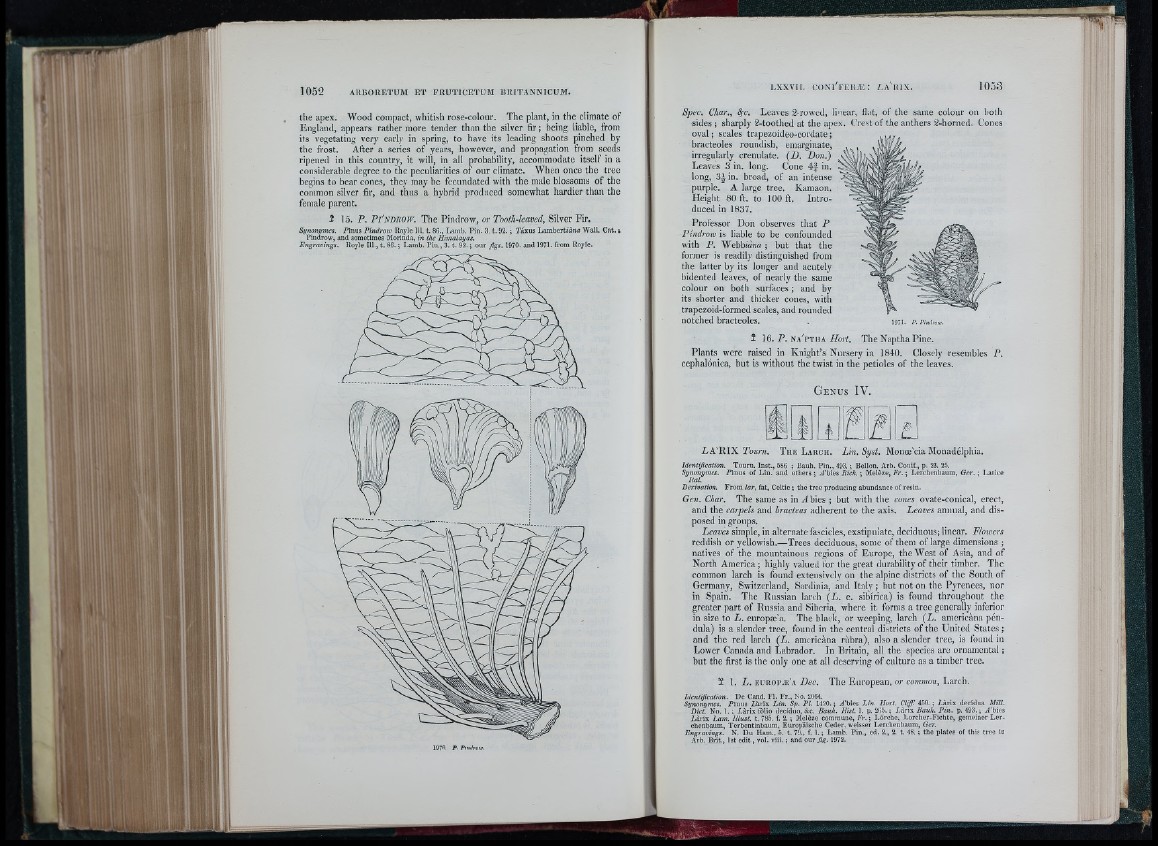
ARBORETUM ET FRUTICETUM BRITANNICUM.
the apex. Wood compact, whitish rose-colour. The plant, in the climate of
England, appears rather more tender than the silver fir; being liable, from
its vegetating very early in spring, to have its leading shoots pinched by
the frost. After a series of years, however, and propagation from seeds
ripened in this country, it will, in all probability, accommodate itself in a
considerable degree to the peculiarities of our climate. When once the tree
begins to bear cones, they may be fecundated with the male blossoms of the
common silver fir, and thus a hybrid produced somewhat hardier than the
female parent.
15. P . P i 'n d r o w . The Pindrow, or Tooth-leaved, Silver Fir.
w
LXXVII. c o n i ' f e r æ : l a i u x . ] 0 ö :3
Spec. Char., (^c. Lcaves 2-rowed, liiiear, flat, of the same colour on both
sides; sharply 2-toothed at the apex. Crest of the anthers 2-horncd. Cones
oval ; scales trapezoideo-cordate ;
bracteoles roundish, emarginate,
irregularly crenulate. (D. Dun.)
Leaves 3 in. long. Cone in.
long, 3^in. broad, of an intense
purple. A large tree. Kamaon.
Height 80 ft. to 100 ft. Introduced
in 1837.
Professor Don observes tliat P
Pindrow is liable to be confounded
with P . Webbidwa ; but that the
former is readily distinguished fi-om
the latter by its longer and acutely
bidented leaves, of nearly the same
colour on both surfaces ; and by
its shorter and thicker cones, with
trapezoid-formed scales, and rounded
notched bracteoles. . 1971. />. Pindro,v.
Î 16. P . n a ' p t h a LforL The Naptha Pine.
Plants were raised in Knight’s Nursery in 1840. Closely resembles P.
cephalônica, but is without the twist in the petioles of the leaves.
G e n u s IV.
Z/A'RIX Pear«. T h e L a r c h . Lhi. Syst. Monoe'cia Monadélphia.
Identification. Tourn. Inst., 586 ; Bauh. Pin., 493. -, Bellon. Arb. Conif., p. 23. 2.5.
Synonymes. P in u s of Lin. and others ; A'bies Rich. : Melèze, Fr. ; Lerchenbaum, Gcr. ; Larice
Hal.
Derivation. From lar, fat, Celtic ; the tree producing abundance of resin.
Gen. Char. The same as in vibies ; but with the cones ovate-conical, erect,
and the carpels and bracteas adherent to the axis. Leaves annual, and disposed
in groups.
Leaves simple, in alternate fascicles, exstipulate, deciduous; linear. Flowers
reddish or yellowish.—Trees deciduous, some of them of large dimensions ;
natives of the mountainous regions of Europe, the W est of Asia, and of
North America ; highly valued tor the great durability of their timber. The
common larch is found extensively on the alpine districts of the South of
Germany, Switzerland, Sardinia, and Italy ; but not on the Pyrenees, nor
in Spain. Tlie Russian larch (L . e. sibirica) is found throughout the
greater part of Russia and Siberia, where it forms a tree generally inferior
in size to L. europæ'a. The black, or weeping, larch {L . americàna péndula)
is a slender tree, found in the central districts of the United States ;
and the red larch (L. americàna rubra), also a slender tree, is found in
Lower Canada and Labrador. In Britain, all the species are ornamental ;
but the first is the only one at all deserving of culture as a timber tree.
¥ 1. L. e u r o p æ ' a The European, or cowwwow. Larch.
Identification. De Cand. Fl. F r., No. 2064.
Synonymes. Plniis i à r i x Lin. Sp. Pl. 1420. ; A'bies Lin. Hort. Cliffi 4-50. ; 7/àrix decìdua Mill.
Dû t. No. 1. ; Zàrix fòlio deciduo, &c. Bauh. Hist. 1. p. 265. ; J.àrix Bauh. F in . p. 493. ; A'bies
i à r ix Lam. lilust. t. 785. f 2. ; Melèze commune, Fr. ; Lörche, .Ivorcher-Fichte, gemeiner Ler-
chenbaum, Terbentinbaum, Europäische Ceder, weisser Lerchenbaum, Ger.
Engravings. N. Du Ham., 5. t. 79., f. 1. ; Lamb. Pin., ed. 2., 2. t. 48. ; the plates of this tree io
Arb. Brit., 1st e d i t , vol. viti. ; and our fig. 1972.